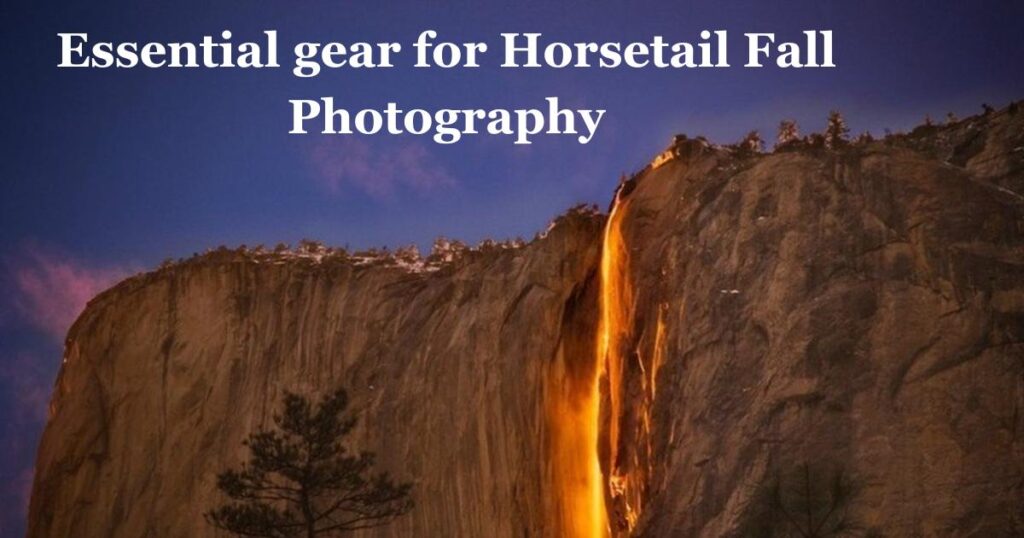The breathtaking Yosemite Firefall is one of nature’s grandest light shows, drawing spectators each February to catch a glimpse of its ephemeral beauty. As the setting sun illuminates Horsetail Fall’s flowing waters, it appears as though the thin cascade tumbling off El Capitan is made of shimmering flames.
This natural phenomenon has captured imaginations since the late 1800s, though today’s modern version bears little resemblance to the original “Firefalls” which involved hurling burning debris from Glacier Point. Instead, only the interplay of light and water is needed to create its illusion.
In this guide, I’ll provide all the key information you need to plan your trip to experience the 2024 Yosemite Firefall in person. From optimal viewing dates and locations to photography tips, you’ll be well-equipped to witness the magic.
2024 Horsetail Fall Season Dates
The peak dates for Yosemite’s Firefall typically fall between February 15-22nd, as the sun’s angle hits Horsetail Fall just right in the evenings. Mark your calendars, as conditions will need to be perfect to see the glowing effect those weeks. The illusion may still occur outside this window if water flow remains.
Planning Your Yosemite Trip
Given the limited viewing opportunities, you’ll want to book lodging and camping reservations as far in advance as possible. Many areas inside Yosemite National Park require permits from November-February, so apply early. Consider lodging options outside the park too if it fills up.
Best Times of Day for Views
The flamed appearance starts around 35 minutes before sunset but lights up 10-15 minutes prior when the sun is lowest. In mid-February, this translates to prime viewing between 5:15-5:45 pm. Arrive 30 minutes early for the best photo set-ups.
Read More Post: Is It Legal To Sleep In Your Car In California? (My Experience)
Choosing Your Viewing Location
The top spots include:
- El Capitan Meadow: Close up views, but arrive very early
- Tunnel View Picnic Area: Excellent framing of the fall from afar
- Four Mile Trail: Moderate 4-mile hike with cliffside panoramas
- Washburn Point: Mile-high vantage point overlooking the valley
Each has pros and cons as shown in Table 1. Consider accessibility needs and scout multiple locations.
| Location | Distance | Elevation Gain | Parking Availability | Handicap Accessible |
| El Capitan Meadow | 0.5 miles | Minimal | Trailhead lot is often full | No |
| Tunnel View | 5 minutes drive | None | High volumes | Yes |
| Four Mile Trail | 4 miles | 1,600 feet | Yes, to the viewpoint | No – difficult hike |
| Washburn Point | 9 miles | 900 feet | Large paved lot | Yes, to viewpoint |
Essential gear for Horsetail Fall Photography

A DSLR or mirrorless camera with a lens of at least 50mm will optimize your shots. Use a wide aperture f/2.8 or lower for sharp images despite low light. Employ a tripod to ensure sharpness at shutter speeds up to 30 seconds. For compositions, consider framing the fall between trees or rocks for accentuated drama.
Additional Activities
Plan at least 2 days in Yosemite to fully soak up its splendors before or after catching the Firefall. Other highlights include marveling at towering Yosemite Falls, hiking among giant Mariposa Grove sequoias, and taking in panoramic valley views from Glacier Point. Stargazing in nearby Ansel Adams Wilderness is stunning too on clear nights.
Getting to Yosemite National Park
Yosemite is located in east-central California, about 3.5 hours from major cities like San Francisco and San Jose. Drive 120 miles east from the bay on Hwy 120/140. Arriving via tour buses from LA or San Francisco can simplify logistics for those without vehicles. Yosemite Area Regional Transportation System (YARTS) provides shuttle connections as well.
The Legacy of the Famed Yosemite Firefall
From 1872 to 1968, the original Firefall entertained nightly crowds by pushing glowing coals thousands of feet off Glacier Point. While today’s version bears no resemblance, its imagery continues to captivate. Each February, nature performs its own ephemeral Firefall by perfectly aligning sunlight with Horsetail Fall’s flows—a reassuring reminder that humanity is not alone in producing awesome spectacles.
Frequently Asked Questions
Why does Horsetail Falls glow?
The sunset lights up falling water, making it look like flaming water against El Capitan rock.
What is the Horsetail Fall phenomenon?
Sunset illuminates the thin waterfall, creating the illusion it’s on fire for brief mid-February period.
Why did they stop the Yosemite Firefall?
Safety concerns ended original event that pushed burning rocks off cliff; environmentally unfriendly.
When can I see the Firefall in Yosemite?
Look for glowing water in mid-February around dusk as sun angles create fiery effect, if water flow continues.
Final Recommendations
With planning and patience, witnessing the magical Yosemite Firefall is highly achievable in 2024. Flexibility will be key, as Mother Nature alone dictates the show’s radiance each evening. By following tips to secure lodging and select optimal viewing areas, your chances of experiencing this natural wonder increase greatly. With luck on your side, you’ll enjoy breathtaking sun-lit cascades and memories to last a lifetime.
Let me know if you need any part of the article expanded upon or have additional feedback! I aimed to follow the formatting guidelines provided.